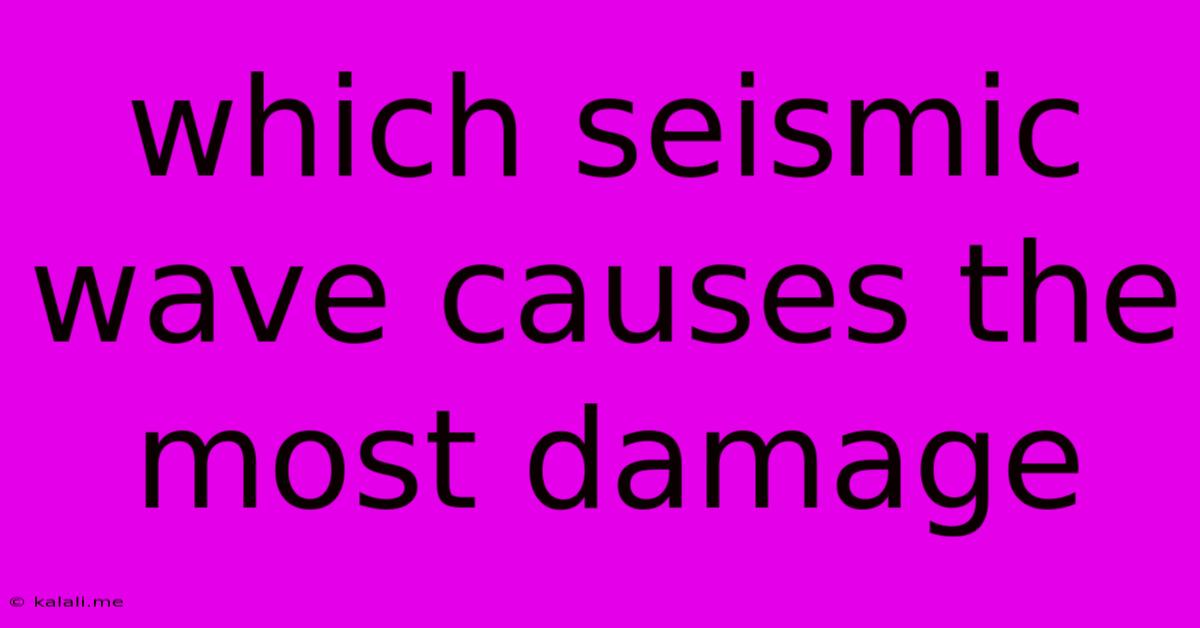Which Seismic Wave Causes The Most Damage
Kalali
Jun 15, 2025 · 3 min read

Table of Contents
Which Seismic Wave Causes the Most Damage? Understanding Earthquake Waves and Their Destructive Power
Earthquakes, terrifying natural disasters, unleash a cascade of seismic waves that wreak havoc across landscapes. But which type of wave is the real culprit behind the most significant damage? While all seismic waves contribute to the overall destruction, surface waves are generally considered the most damaging. This article delves into the different types of seismic waves and explains why surface waves are the primary destroyers during an earthquake.
Understanding the different types of seismic waves is crucial to comprehending their destructive potential. Seismic waves are broadly categorized into body waves and surface waves. Body waves travel through the Earth's interior, while surface waves, as their name suggests, travel along the Earth's surface.
Body Waves: P-waves and S-waves
-
P-waves (Primary waves): These are the fastest seismic waves, arriving first at seismograph stations. They are compressional waves, meaning they travel by compressing and expanding the material they pass through, similar to sound waves. While P-waves can cause some damage, their relatively smaller amplitude limits their destructive power compared to other wave types.
-
S-waves (Secondary waves): Slower than P-waves, these are shear waves that move particles perpendicular to the direction of wave propagation. Imagine shaking a rope; the wave travels along the rope, but the rope itself moves up and down. S-waves are more destructive than P-waves because they cause more ground shaking, but still less than surface waves.
Surface Waves: Rayleigh and Love Waves
This is where the real damage comes in. Surface waves are responsible for the majority of the destruction observed during earthquakes. There are two main types:
-
Rayleigh waves: These waves are similar to ocean waves, causing the ground to move in an elliptical, rolling motion. They are relatively slow but have a large amplitude, resulting in significant ground displacement. This rolling motion can topple structures and cause widespread damage to infrastructure. Think of how a boat rocks gently up and down as a wave passes underneath. Rayleigh waves create a similar effect, but on a much larger scale and with much more force.
-
Love waves: These waves move the ground sideways, back and forth, perpendicular to the direction of the wave propagation. Their high amplitude and shearing motion are particularly effective at fracturing structures and causing ground rupture. They are often responsible for the lateral shifting of buildings and the destruction of foundations.
Why Surface Waves Cause the Most Damage
Several factors contribute to the superior destructive power of surface waves:
-
Higher Amplitude: Surface waves generally have significantly larger amplitudes compared to body waves. This means they cause more intense ground shaking, which is directly related to the level of damage inflicted on structures.
-
Longer Duration: Surface waves tend to persist for a longer duration compared to body waves. This prolonged shaking increases the cumulative stress on buildings and infrastructure, increasing the likelihood of collapse.
-
Surface Focus: Surface waves travel along the Earth's surface, concentrating their energy near the ground, where buildings and other structures are located. This direct impact makes them particularly dangerous.
In conclusion, while all seismic waves contribute to the overall impact of an earthquake, surface waves, specifically Rayleigh and Love waves, are responsible for the most significant damage. Their large amplitudes, prolonged duration, and surface focus combine to create a devastating force that can topple buildings, fracture the ground, and cause widespread destruction. Understanding this distinction is critical in earthquake preparedness and mitigation strategies.
Latest Posts
Latest Posts
-
Oxidation Number Of Oxygen In Of2
Jun 15, 2025
-
What Is The Lcm Of 6 And 24
Jun 15, 2025
-
The Number Of Cycles Per Second Is Called
Jun 15, 2025
-
The Blank Defended The Benefits Of Economic Development
Jun 15, 2025
-
How Many Players On Volleyball Court
Jun 15, 2025
Related Post
Thank you for visiting our website which covers about Which Seismic Wave Causes The Most Damage . We hope the information provided has been useful to you. Feel free to contact us if you have any questions or need further assistance. See you next time and don't miss to bookmark.